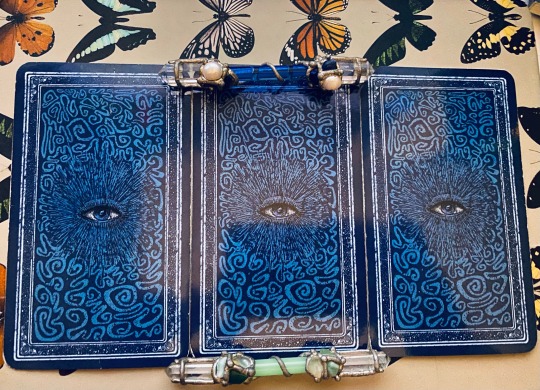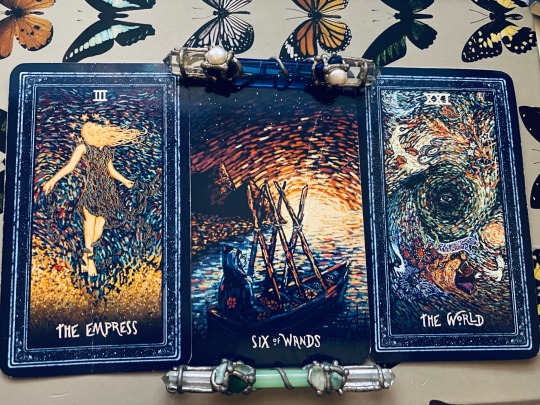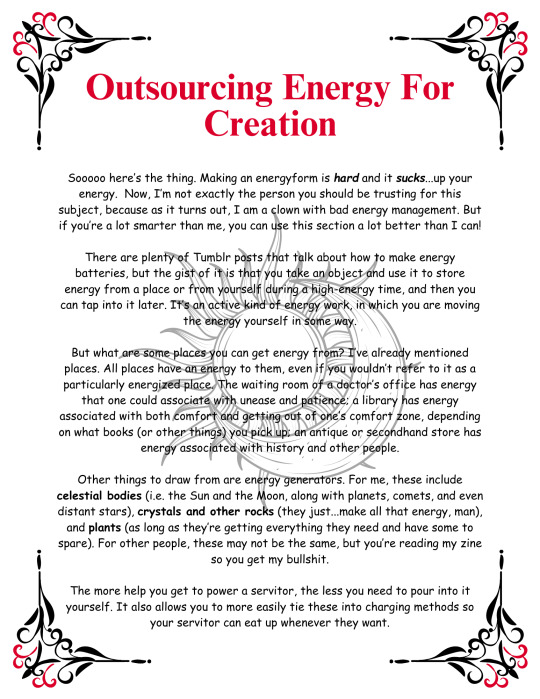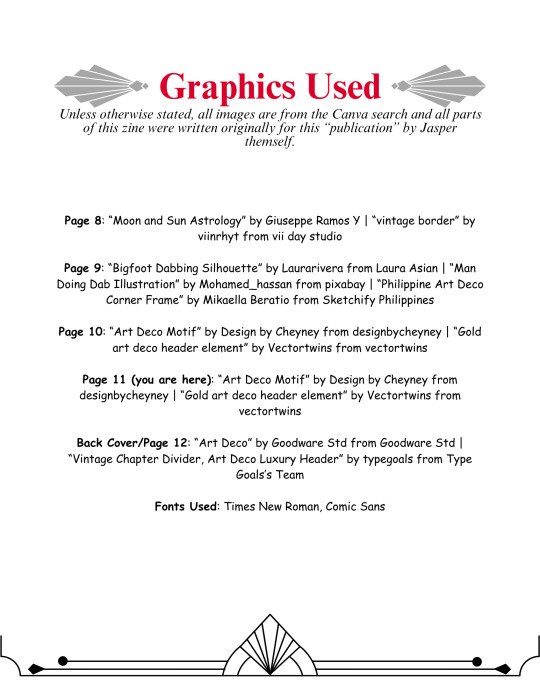#energy work
Explore tagged Tumblr posts
Text
A Brief Introduction to Energy Work
Energy work as most of us know it was heavily influenced by certain beliefs that the body's health depended on a healthy flow or balance of vital force, and that said force could be manipulated through certain practices. The whole concept of qi energy and qigong were pretty big influences here. Other influences included persistent European beliefs in vitalism, the concept of animal magnetism, and a rising awareness of electricity and radiation, which to many people seemed to provide justification for many old paranormal and metaphysical beliefs.
Now of course, we now know that vitalism just isn't a thing and that flickering lights in your house have more to do with bad wiring than ghosts, but energy work itself continues to persist. (Although these days, it's often justified with terrible misunderstandings of quantum physics.)
I also feel that I'd be irresponsible not to mention that there is no evidence that energy healing can be relied upon to heal serious medical issues, and that many people offering energy healing sessions for sale are basically just scammers. If you ever find yourself in a position where you have to choose between paying for an energy healing service and paying for evidence-based medicine, put your money on evidence-based medicine.
With that out of the way, I do believe that energy work can have benefits. Like in my own experience, energy work can't cure chronic depression, but it can sometimes lift some of those heavy feelings. It might not completely cure your flu, but it can most probably help you relax, which will help your immune system work better. And I really can't argue with the efficacy of energy shielding so far as warding goes.
So with all that out of the way, how does one practice energy work?
Energy work is often practiced by visualizing energy moving and converging wherever you need it, often using your hands, fingers, or something like a wand to focus it. Let's say for example that you feel a sense of tightness or heaviness in your sternum area. You might place your fingers over it and visualize a white light clearing away the tension.
Energy work can also include drawing symbols. My go-to for banishing that sense of heaviness is to trace my finger over my sternum in a sun shape (a regular old circle with rays, much like this one 🌞), visualizing the lines in a bright sunny yellow.
It can also include breathwork. Here's one possible personal shielding technique using this: Take a deep inhale while visualizing protective energy from the earth coming up into your body and filling your core. Then exhale while imagining this energy pushing out of your body and forming a protective shield.
Also, while many energy work techniques involve using energy from positive emotions, you don't have to limit yourself to them. You can put your shitty emotions to good use. For example, if you're warding your space by tracing protective symbols on your walls, you might channel aggressive feelings into them to give them some bite.
Now of course, these aren't all the things you can do with energy work, or all the ways you can practice energy work. This is just a quick intro. But if you combine even just this basic comprehension with a broader comprehension of color correspondences and symbology, you'll find that it's pretty versatile.
Happy witchin'!
66 notes
·
View notes
Text
Ways to Strengthen Your Magical Powers
Loving Self-Talk

I am a being of power and wisdom. My magic flows naturally from within me, connected to the great currents of the universe. I honor my gifts, and I trust myself to use them well.
I am protected. My energy is sovereign, my space sacred. No force can take what is mine unless I allow it—and I allow only what strengthens and uplifts me.
I am aligned with the forces of nature. The elements move with me, the cycles of the moon and sun guide me, and I am always where I need to be.
My spirit is radiant and untouchable. Even in difficult times, my inner light burns strong. No darkness can consume me, for I am the keeper of my own fire.
I am worthy of my own love and care. I honor my emotions, my intuition, and my needs. I give myself the same kindness I would offer a beloved friend.
I grow in power every day. With every spell, every ritual, every moment of awareness, I refine my craft and deepen my connection to the Source.
I do not fear those who try to harm me. Their power is limited, but mine is infinite. I stand firm, knowing that the universe supports me.
I am free. No bindings, no past wounds, no illusions can hold me. I choose my path with clarity, courage, and joy.
#witchblr#witchcraft#spellcraft#witch life#witchcr#spellwork#energy work#personal power#witchs heart#witches
1 note
·
View note
Text

Introduction to Shielding
If you haven’t already, check out my lessons on visualisation for the basic knowledge you’ll need to begin practicing shielding.
So what is shielding?
Shielding is a manipulation of energy, used to create a barrier between yourself and unwanted, usually negative or malicious energies. It’s a basic aspect of spellwork that everyone, beginner or experienced, should use to keep themselves safe.
What can I use shielding for?
Some beginner-level uses for shielding are drawing a circle, or casting a spell. A more experienced individual might use shielding in astral travel or spirit work, where there are a lot more malicious energies involved. Personally, I use shielding as often as possible, for instance when I do tarot readings, spells, spirit work, shadow work, and especially cursing. It gives that extra guarantee that you won't flood your personal space with unwanted energies.
Other uses include shielding against real-life dangers, to a certain degree. I often shield when I am walking through town at night for extra protection. But please remember to take other measures too! Call someone, pretend to be on the phone, plan your route, and even carry pepper spray if it's legal where you are.
An easy shielding method:
The easiest way to explain this is to think of your energy as a physical manifestation. Think how power attacks are shown in anime or cartoons - a streak of colour or light, or an element. Make it personable to you: fire signs (Leo/Aries/Sagittarius) might visualise fire, or a red energy or light etc.
Firstly, some people prefer to cleanse before shielding. I don't think its all that necessary but the choice is yours.
Begin by easing yourself into meditation. Get comfortable, and use whichever technique works for you. I have various methods for this in my visualisation lessons if you are struggling.
Attempt to visualise the energies surrounding you in your mind. It might be a swirling colour of light, almost like a cloud of dust. It could be flames, it could be water. Maybe try to see it held within your hand.
Now, attempt to shape this energy around your entire body. You might want to start with a bubble or a cube surrounding you. Feel this shape surrounding and protecting you. Visualise negative and unwanted energies being held back by it.
You can also layer shields, so if you are working with a particularly malicious energy you might want to have multiple shapes surrounding you, all within each other. You can also work with deities or spirits to ask them to shield you too.
Shielding Incantation
When I am shielding, I recite a spell as well as using visualisation techniques.
The shield of protection, I carry it strong, No ill wishes or trouble shall come along, You cannot harm me, or weaken my soul, My light is my weapon, and peace is my goal.
Try it out for yourself and let me know in the comments how it went! Thank you as always for reading. Please message for requests.
#hedge witch#pagan witch#witch#witch community#witchblr#witchcore#witchcraft#witches#visualization#shielding#spellwork#spellcasting#spells#magick#folk magic#folk witchcraft#traditional witchcraft#wiccablr#wicca#pagan#paganism#meditation#manifesting#energy work#energy witch#magic#wolfhoundlessons
2K notes
·
View notes
Note
Hi can i have a free reading on what a new girl i met thinks of me? recently got drunk with her and trauma dumped 😀😭 Her initials are SD and mine are AP.
thank you
✨ free psychic reading by egyptian sand! (7$ paid readings are also opened!) ✨
i see the shape of a book, which represents knowledge, curiosity, and understanding 📖. this suggests that sd sees you as someone with depth, someone who has a lot to share. she may be processing everything you told her and trying to understand you better. she doesn’t seem to judge - rather, she might be intrigued by what she learned about you.
next, there is a wave-like pattern, symbolizing emotions and unpredictability 🌊. this shows that your interaction left a strong impression on her, but she might feel a mix of emotions. she could be unsure of how to respond or process what happened. she doesn’t dislike you, but she might need some time to fully understand how she feels about what you shared.
finally, i see a key, which represents opportunity, trust, and unlocking something new 🔑. this suggests that your conversation may have opened a door between you. she could see you as someone who trusts easily or someone she now feels responsible for in some way. depending on her personality, she may either want to deepen the connection or keep a slight emotional distance if she’s unsure how to handle deep conversations.
summary: sd likely sees you as an interesting and open person with a lot of depth. she might feel a mix of curiosity and uncertainty about the conversation, but it has left a mark on her. depending on how she processes emotions, this could bring you closer or make her take a step back to reflect. if you want to reconnect, giving her space to reach out might be the best approach 🗝️✨
got questions or need some insight into your life? i'm here to help with personal psychic readings! for just $7, you can get answers to up to 7 questions! more info at:
in case anyone else here on tumblr would like a free psychic reading, click the link and follow the instructions (i answer only to those who follow the instructions, thank you): https://www.tumblr.com/psychics4unet/773593300218314752/free-psychic-reading-with-egyptian-sand
#shifting#shifting community#desired reality#shiftblr#void state#law of assumption#lucid dreaming#astral projection#spirituality#intuition#energy work#Supernatural#astrology#tarot#magick#magic#ghosts#ghost#witch#the void state#shifting motivation#chakras#spells#dreams#paranormal#dream#angels#psychic
2 notes
·
View notes
Text


💫🔮 pick a card that you feel the most called to and receive a message below the cut 🃏 ✨


card one // the empress
(libra moon/venus, venus in taurus, taurus midheaven, venus in the 2nd & 4th house)
things feel good, don’t they? the checkbook balances and you get the things you want. you are rising above and allowing self growth to take place. take on any challenges your way with a clear level head and you’ll be light as a feather as you ascend further to the best version of yourself. creativity or love may be fueling you at this time and take some time to decompress with ritualistic self care and relaxation.

card two // six of wands
(leo sun/rising, pisces moon, natal mercury rx, sun in 10th)
you may have went through hell and back to get to this point. the end is right along the horizon, i promise you. please don’t get discouraged by situations or opinions thrown at you. you’ve worked so hard and your efforts are about to show. remember to stay humble and allow the struggles you’ve faced to transform you— not hold you back. just a few more steps and victory at last.

card three // the world
(aquarius rising, pluto in scorpio, saturn in capricorn or 10h)
in case no one has told you, the universe is proud of you. you’ve hit tremendous milestones throughout a rocky road but you may be jaded or not seeing the whole picture. in the grand scheme of things, your mistakes or misfortune does not matter when the world moves on twice as fast. if you feel like you’re spinning under the pressure, this may be a good time to start a new hobby. there’s a pent up energy that is just begging to be released.

#tarotbyroxie#pick a card#pick a pile#pick a picture#tarot#tarot readings#astro#astro observations#astro community#astrology#astro tarot#divination#signs#law of manifestation#energy work#witchblr#tarot witch#tarot cards#tarotcommunity#tarot deck#aesthetic#witch community#libra moon#taurus venus#12th house#leo rising
225 notes
·
View notes
Text
Amethyst Mini Wands: Tools for Healing and Spiritual Growth
Amethyst mini wands are compact, polished crystals shaped to a point, harnessing the potent energies of amethyst—a variety of quartz celebrated for its vibrant purple hues and extensive metaphysical properties. These mini wands serve as versatile tools in various spiritual and healing practices, offering both aesthetic appeal and functional benefits.
Metaphysical Properties of Amethyst
Spiritual Awareness and Intuition: Amethyst enhances spiritual awareness and intuition. It stimulates the third eye and crown chakras, facilitating deeper meditation and a stronger connection to the divine.
Emotional Balance: Known as a natural tranquilizer, amethyst alleviates stress and anxiety, promoting emotional stability and inner peace.
Protection: This crystal forms a protective shield around the aura, guarding against negative energies and psychic attacks.
Uses of Amethyst Mini Wands
Energy Healing: Practitioners use amethyst wands to direct healing energy, clear blockages, and balance the body's energy centers.
Meditation: Holding an amethyst wand during meditation can deepen focus, enhance spiritual connection, and promote a serene state of mind.
Sleep Aid: Placing an amethyst wand under the pillow is believed to alleviate insomnia and encourage restful sleep.
Stress Relief: Carrying an amethyst wand can serve as a calming talisman, helping to soothe irritability and balance mood swings.
Caring for Your Amethyst Wand
To maintain its energetic potency, regularly cleanse your amethyst wand by rinsing it under running water or smudging it with sage. Recharging can be achieved by placing it under moonlight or near a clear quartz cluster.
Incorporating an amethyst mini wand into your spiritual practice can enhance various aspects of your well-being, offering a blend of beauty, functionality, and profound metaphysical benefits.

1 note
·
View note
Text

Gotta love the scams.
#energy work#beginner witch#pagan#witch#witch community#witch tips#witchblr#witchcraft#baby witch#pagan witch#pagan blog#paganblr#paganism#metaphysics#metaphysical#energy manipulation#diviniation#spiritual scams
790 notes
·
View notes
Text
harnessing and using external energies
one of the mistakes i made as a beginner witch is using my own energy to power spells, which is exhausting. a good way to combat that involves channeling energy from an external source - i will use the moon as an example.
no, it's not to say that channeling energy is easier or not exhausting in itself - it's to say that you have options at your disposal to keep yourself from quickly and constantly burning out.
channeling energy - gather energy from an external source such as the moon. i like to imagine a silver string that connects us together, a tether if you will. typically i visualize this energy as a ball of light forming in my core or my hands.
direct - once you've gathered your energy, where do you want it to go? directly into a spell? saved for a rainy day? into a physical object of sorts? or maybe keep it within yourself?
charging - using that energy to power spells, enchantments, items, etc.
battery - store energy for later use - i like using quartz towers - then you can use that to power objects without having to channel energy every. single. time.
you can easily compare this concept to charging electronics.
there's a couple ways to charge a phone - you can either plug it straight into the wall, or charge up your power bank first and use that to charge your phone - channeling and charging in magic follows the same process.
the phone in this example is the vessel that holds energy.
electricity from wall outlet = moon aka energy source
charging cord = tether to the moon for channeling
phone = the thing you're transferring energy to aka charging
the intent to plug your phone in to charge = directing energy
actually plugging your phone in = charging
power bank = energy you gathered and stored away
choosing the outlet vs the power bank = immediate use of lunar energy vs storage for later use
once your phone is charged, what are you gonna do with it? open tumblr? send a text? now you get to decide where that energy is going to be sent and what it'll be used for (storage, spells, enchantments, etc.).
tips & advice
keep in mind that your phone isn't going to charge if it's dead and you only leave it plugged in for like 5 minutes. take your time to sit with the moon, have a conversation, meditate alongside one another, and get to know each other before asking for help.
i don't advise channeling energy directly into yourself to save for later use. it will eventually burn out, drain you, and then you're back to square one.
stored energies still need to be maintained and recharged, just like a battery.
what to do afterwards
sever the tie that connects you to the moon - be nice and give thanks.
if you've used energy to cast a spell immediately after channeling, close out your spell however you want (like, taking down a circle if you've cast one).
if you chose to store that energy away instead, set the vessel aside for later use.
ground yourself to shake off any lingering static, so to speak.
as with anything, your mileage may vary - do what works for you and with whatever energy you choose. good luck!
♡ luna
© 2025 ad-caelestia
#witchblr#witchcraft#witch#witchy#witches of tumblr#magic#channeling energy#charging objects#cosmic witchcraft#cosmic witch#energy work#beginner witchcraft#beginner witch#ad-caelestia
293 notes
·
View notes
Text
Jasper's Energyform Zine












Hey. I made a zine about thoughtforms, servitors, and energyforms. It's free. It's yours now. Print it out. Eat it. I don't care. Just don't pretend you wrote it when I did all of this and screamed at the formatting and paid for Canva shit to accomplish this.
Download it as a PDF here.
#jasper post#zine#energy work#chaos magic#pop culture#pop culture magic#pop culture magick#pop culture witch#pop culture witchcraft#advwitchblr#grownasswitches#energyforms
393 notes
·
View notes
Text



#posted#quote#sakti#sakti healing#saktihealing#love#divine love#higher self#shadow self#shadow work#source#god#transformation#ripple effect#healing#self healing#spiritual healing#spirituality#spiritual growth#personal growth#consciousness#self love#mindset#energy work#spiritual hygiene#let go#release#full moon#Aquarius#aquarius full moon
449 notes
·
View notes
Text
Trees spontaneously combusting miles away from the fire... Are energy weapons sparking fires?
#pay attention#educate yourselves#educate yourself#reeducate yourselves#knowledge is power#reeducate yourself#think about it#think for yourselves#think for yourself#do your homework#do your research#do your own research#do some research#ask yourself questions#question everything#government corruption#government secrets#news#evil lives here#truth be told#energy work#direct energy weapons#crimes against humanity
243 notes
·
View notes
Text
Six Directions Banishing for Removal of Malfeasance, and Protection Against Same
A version of a spell taught to me by the Beloved Goat, similar to other rituals that have been taught to me in the past. This spell requires no materials, but may take some playing around with it in order to get the feel of things.
The feel of things is the necessary component for this spell. We also need these definitions* to help feel out the right things:
Malfeasance: Wrongdoing against responsibilities and duties. Something should have happened according to honor and obligation, but instead something wrong was done.
Betrayal: Violation of trust.
Harm: Hurt, damage, unjust effects.

Identifying the problem
The first step is to conjure into your awareness the powers of malfeasance, betrayal, and harm that have been enacted against you.
OBFUK (observe, believe, feel, understand, or know) that within the universe are things harmful to you. Within the universe, malfeasance has been done against you.
Stay with this idea, considering that this is a force that exists in energetic form, and can therefore be manipulated and changed with energy. Play with the idea until you are able to OBFUK that malfeasance against you exists and can be dealt with.
Repeat this step with the concepts of betrayal and harm.
The more you understand and feel these ideas, the better. In this stage you are casting a net by defining what it is you want to deal with.
Contemplate what it really means to have your trust violated. Contemplate what it means for people to have responsibilities to you, and the debt that is created to your wellbeing when these responsibilities are ignored or neglected.
Dwell with these ideas until you have got a pretty good idea of what it is you want to banish and protect against. This stage may initially take several minutes, but with practice may be completed speedily.

Banishing
The second step is to banish malfeasance, betrayal, and harm in six directions. This step is the same for each direction, except you just turn in a circle and/or or re-envision the bisecting line.
Face north. Mentally bisect your body at the midpoint (solar plexus if lying down, middle of skull to top of feet if standing, etc).
OBFUK (observe, believe, feel, understand, or know) that this line of bisection extends infinitely across the universe. You will repeat this envisioning, so play around with it until you are comfortable with it.
Once you have gotten steady with the idea that a divide is going through your body that completely separates the universe into "the north," you are ready to banish.
Say, think, or sign, something quite like the following (note the four distinct sections; identifying problem, setting intent, commanding action, demanding results):
I see the malfeasance that is to the north of me. I see the betrayal that is to the north of me. I see the harm that is to the north of me. I revoke these things. I rebuke these things. I banish these things. They fade into the earth and into the blackness between stars. They turn to ash and dust and settle into the forest and into nebulae. They scatter to the winds and become the colors in the sunset. They sink into the waters and become algae the fish and frogs feed on. To the north of me, malfeasance, betrayal, and harm enacted against me are banished. They are no more.
It's best to stay with this portion until you are personally satisfied that you've said the right things. You may like to go on a diatribe about how the energies are burned by hellfire and consumed by demons, and so on.
The spell is all the better if you stay with each direction and gnash on the energies until you are satisfied that you have settled on the right words. Repeat sections as many times as you like, using any words that inspire you. Polish is less effective than conviction.

Protecting
After you have banished in one direction, re-focus on the bisecting line. In the middle of your body, on the axis of that line, is a core of power.**
OBFUK (observe, believe, feel, understand, or know) that this is your personal power.
That power is ready to flow around you in a spherical shield that protects you.
Say, think, or sign the following:
To the north, I am protected. I am protected from malfeasance. I am protected from betrayal. I am protected from harm.
As you intone this, OBFUK that an impermeable, impassable, perfect shell of protective power pours forth from you in a hemisphere, wrapping around you from east to west, entirely protecting you from what is in the north.
Repeat this portion as many times as necessary, or play around with it a bit, until you feel satisfied the protection has occurred.

Moving in 6 Directions
Repeat the Banishing and Protection step for each of the six directions (north, south, east, west, above, below).
You may go in any order you like. I move clockwise from north, hitting east, south, and west; then turning north again to finish above and below.
Each time you work in a new direction, adjust how you envision the bisecting line that goes through your body.
Your goal is to envision the line in such a way that all six lines intersect at the same point, if possible, marking a singular point. The banishing pushes everything outwards from this singular point.
In order to accomplish this, moving around or readjusting yourself may be necessary.
Remember that each time you conjure the Protection, it is a hemisphere. This means it necessarily overlaps the others. Half of the eastern hemisphere will overlap north, and the other half will overlap the south. The above and below hemispheres will encapsulate all for hemispheres before it.
You may find that banishment and protection are easier or harder in different directions, which is normal. Work in each direction until you are satisfied both with the banishment and the protection.
As you move through subsequent directions, you may find your hemispheres interlock or layer in ways you weren't expecting. Let the energy moves as it desires, as long as it conforms with your standards of protection.
When you have worked in 6 directions and laid down 6 hemispheres (to create 3 total overlapping spheres of protection), move to the finish.

Sealing
There are 3 complete spheres of protection around you; one created by the joining of north and south, one created by the joining of east and west, and one created by the joining of above and below.
Whether or not these spheres seemed to combine, or were combined, in earlier steps, seal everything now to properly finish the protection.
With your focus on yourself (not necessarily placed upon any direction), intone the following:
The protections to the north of me and to the south of me join together in perfect unison and perfect harmony. I am infinitely protected from all malfeasance, all betrayal, and all harm. The protections to the east of me and to the west of me join together in perfect unison and perfect harmony. I am infinitely protected from all malfeasance, all betrayal, and all harm. The protections above me and below me join together in perfect unison and perfect harmony. I am infinitely protected from all malfeasance, all betrayal, and all harm. I am infinitely protected from all malfeasance, all betrayal, and all harm.
The spell is complete.
[*The definitions are for the purpose of this spell, so we can sniff out what we are working on like a bloodhound sniffing out a rabbit. Dictionary definitions may differ.]
[**This is true for the purposes of the spell but not necessarily true in any other circumstance]
155 notes
·
View notes
Text
𝕿𝖍𝖊 𝕻𝖔𝖜𝖊𝖗 𝖔𝖋 𝕴𝖓𝖙𝖊𝖓𝖙: 𝕱𝖔𝖈𝖚𝖘𝖎𝖓𝖌 𝖄𝖔𝖚𝖗 𝕸𝖆𝖌𝖎𝖈𝖆𝖑 𝕰𝖓𝖊𝖗𝖌𝖞

In the realm of magic, one principle stands above the rest: the power of intent. At its core, intent is the driving force behind every spell, ritual, and magical endeavor. Whether you’re a seasoned practitioner or just beginning your journey, understanding and harnessing the power of your intent can profoundly enhance your magical practice.
What is Intent in Magic?
Intent is the focused desire and purpose you infuse into your magical workings. It is the clear, conscious will you project into the universe to manifest a specific outcome. Think of intent as the blueprint for your magic—it gives direction and purpose to your energy, guiding it toward your desired goal.
Why Intent Matters
Clarity and Focus: A clear intent provides a focal point for your magical energy. Without a well-defined goal, your energy can scatter, diluting its effectiveness. Like an archer aiming at a target, your intent narrows your focus, ensuring your energy hits its mark
Alignment with the Universe: When your intent is clear, you align yourself with the natural flow of universal energy. This alignment amplifies your power, making it easier for the universe to respond to your wishes. It’s like tuning into the right frequency on a radio—when you’re on the right channel, everything comes through more clearly.
Empowerment and Confidence: Knowing what you want and why you want it strengthens your confidence. This self-assuredness not only boosts your magical prowess but also enhances your overall sense of empowerment in life.
How to Harness the Power of Intent
Define Your Goal: Before casting any spell or performing a ritual, take time to clearly define your goal. What do you want to achieve? Be specific. Instead of saying, “I want to be happy,” you might say, “I want to find joy and contentment in my daily life.”
Visualize Your Desire: Visualization is a powerful tool for focusing your intent. Close your eyes and vividly imagine the outcome you desire. Engage all your senses—see it, hear it, feel it, smell it, and even taste it if applicable. The more detailed your visualization, the stronger your intent.
Use Affirmations: Positive affirmations reinforce your intent. Create a short, positive statement that encapsulates your goal and repeat it regularly. For example, if you seek financial abundance, you might affirm, “I am open to receiving wealth and prosperity.”
Infuse Emotion: Emotion is the fuel for your intent. Feel the emotions associated with achieving your goal—joy, relief, excitement, love. Emotions heighten your energy and make your intent more compelling to the universe.
Release and Trust: Once you’ve set your intent, release it into the universe and trust the process. Holding on too tightly can create resistance. Have faith that the universe will respond in the best possible way and at the right time.
Practical Exercises to Strengthen Your Intent
Meditation: Regular meditation helps quiet your mind and enhances your focus. Spend a few minutes each day meditating on your intent, allowing it to sink deeply into your subconscious.
Journaling: Write down your goals and the reasons behind them. Journaling clarifies your thoughts and solidifies your intent. Revisit your entries to stay aligned with your desires.
Rituals and Spellwork: Design rituals and spells that resonate with your intent. Use symbols, colors, herbs, and crystals that correspond to your goal. The act of performing a ritual reinforces your intent through action and symbolism.
The power of intent is the cornerstone of effective magic. By focusing your magical energy with a clear, purposeful intent, you can manifest your desires and create profound changes in your life. Remember, the universe responds to the energy you put out, so make sure your intent is aligned with your true desires and highest good. With practice and dedication, you’ll find that your ability to harness the power of intent becomes second nature, transforming your magical practice and your life.
Embrace the power of your intent and watch as your magical journey unfolds with greater clarity, purpose, and success.
#spirituality#divination#witchblr#tarot#witch#witchcraft#free tarot readings#witch community#astrology#manifestation#energy#energy work#witchcore#eclectic witch#manifestingmindset#law of assumption#law of manifestation#law of abundance#law of attraction#witches of tumblr#beginner witch#witch blog#high priestess house#higher self#spiritual beliefs#spiritual connection#spiritual healing#spiritual awakening#spiritualism#spiritual journey
296 notes
·
View notes
Text

LESSONS IN VISUALISATION.
Reupload from my old account but with some changes! I was @fangwitch before.
Part two here.
Visualisation is incredibly useful in witchcraft as it is the base of energy work. From this, you can do all kinds of practices.
You can use visualisation as a tool for meditation, astral travel, and wider spellwork such as sending energy into objects among other things.
So, how do I start?
Here’s a few basic exercises for you to practice. They're very simple and many of you will probably be able to pick it up easily if you’ve already done visualisation techniques!
Exercise One
1. If you're new to visualisation, you’ll need a quiet area where you’ll be comfortable. Even lying in bed and putting white noise in your headphones works. Get rid of all distractions, put your phone on silent if you can.
2. Close your eyes, and imagine a mountain. It's important to remember that not everyone is capable of picturing an exact image in their head - some people only conjure the idea of a mountain or a blurry image instead. Don't get frustrated with yourself, these techniques can be built on over time but should still be personalised to your abilities
3. Allow any passing thoughts to float by like clouds, inconsequential to the strength of your mountain. Breathe slow and deep as they pass you by. Bring your focus back to the mountain each time your mind drifts away.
4. You can use this technique as a way to ease yourself into practicing regular meditation too. Try it for five minutes a day, and you can even expand on what the mountain looks like, what animals might be there, and what it sounds and smells like, in time.
Exercise Two
1. Begin again by getting comfortable somewhere quiet and without distractions. Take some slow, deep breaths and close your eyes.
2. Imagine an apple, any old apple. Slowly, focus in on the details. Does it have leaves, more than one colour? Consider each tiny detail of the apple you’ve created.
3. Next, imagine a knife. Consider the size, the weight of the handle and what kind of metal it might be made of. Once you have an understanding of the details of your knife, take it and cut the apple in half. Focus on the detail inside: the colour, how many seeds there are etc. The more detail, the better.
4. Now, use your senses. What does the apple feel like, smell like? Bite into it and taste it. You’re using visualisation to not only see the apple but understand everything about it, how it interacts with the world around it.
5. With regular practice, you should be able to visualise and interact with objects in your mind. Practice often with anything you like.
Thank you for reading. I am trying to write regular lessons again, so please reply or message with any witchy info you would be interested in learning!
#traditional witchcraft#folk magic#folk witchcraft#magick#altar#pagan#hedge witch#witch#baby witch#beginner witch#pagan witch#witch community#witchblr#witchcraft#witches#witchcore#witchy#wiccan#wicca#pagan wicca#wiccablr#spellwork#spells#spellcasting#meditation#visualization#occult#energy work#energy witch#wolfhoundlessons
294 notes
·
View notes
